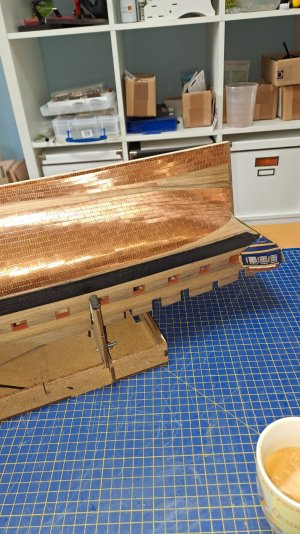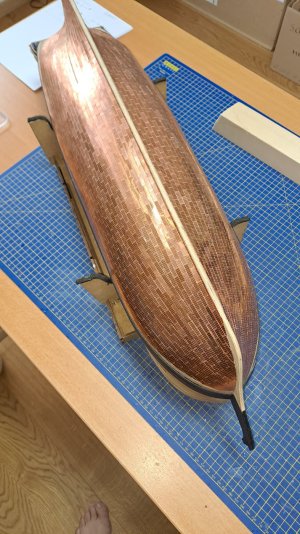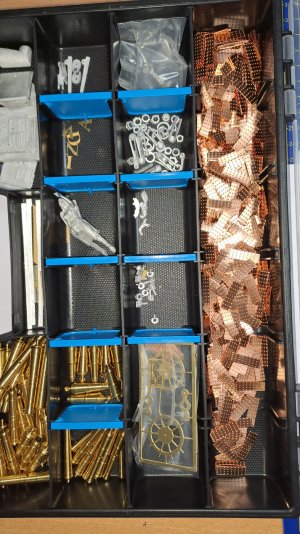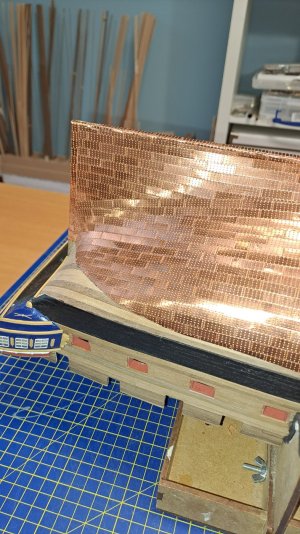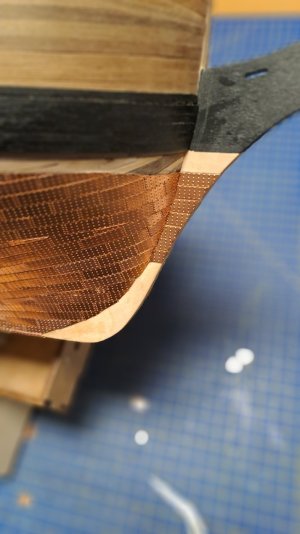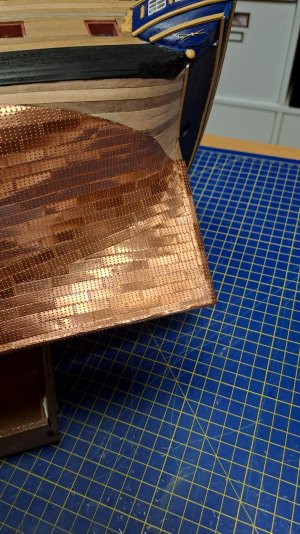-

Win a Free Custom Engraved Brass Coin!!!
As a way to introduce our brass coins to the community, we will raffle off a free coin during the month of August. Follow link ABOVE for instructions for entering.
You are using an out of date browser. It may not display this or other websites correctly.
You should upgrade or use an alternative browser.
You should upgrade or use an alternative browser.
HMS Diana by Caldercraft
- Thread starter HMSFly
- Start date
- Watchers 37
-
- Tags
- caldercraft diana
Thx Allan, I do my best...
Hi Marc
The copper plating looks very good, are these plates as good as the ones you used on your Constitution?
Tony
Love the overlapping appearance! It is hard to tell from the photos but are the nails sticking up on the plates? Just as an FYI they were hammered into the wood and wound up with dents in the plates rather than sticking up like rivets which would have created a lot of drag and reduced speed capabilities. The nails were usually about 1/4" with 1/2" heads (0.2mm at 1:64) Some of the new kit designs have etched nail marks which looks more like the real thing. The photo below is a plate from the USS Constitution.
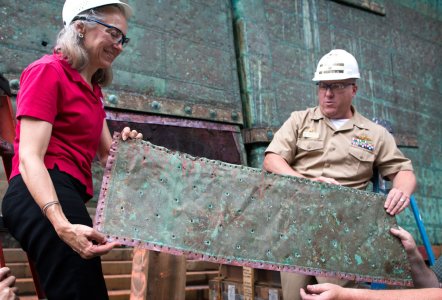
Another example
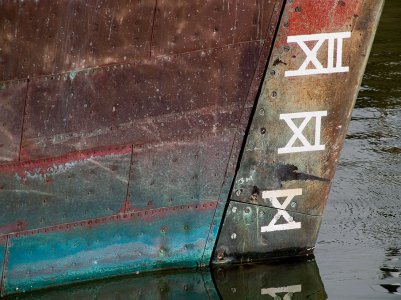

Another example

Hello Tony,
I don't have to think long: the copper plates of the Diana are much nicer (comparable to a Braille print) and relatively large (18 * 5 mm).
When gluing you have to make sure that they fit together perfectly (otherwise you will of course see the wood), which is not easy... and since you use CA glue, there is no margin for error. The plates are also more difficult to trim (I mean to cut to size, I use razor-sharp scissors for this) because the rivets form balls...
Cheers
Marc

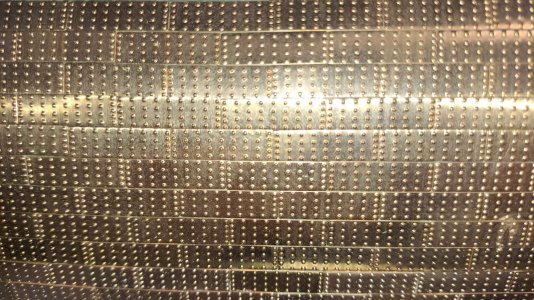
I don't have to think long: the copper plates of the Diana are much nicer (comparable to a Braille print) and relatively large (18 * 5 mm).
When gluing you have to make sure that they fit together perfectly (otherwise you will of course see the wood), which is not easy... and since you use CA glue, there is no margin for error. The plates are also more difficult to trim (I mean to cut to size, I use razor-sharp scissors for this) because the rivets form balls...
Cheers
Marc


Marc your coppering is progressing very well. It looks super nice.same on other side...
The same on the other side remark is in my opinion one of the most important aspects of building ships,..... symmetry. I have not succeeded in obtaining symmetry in my build, and admire your success in this vital area.
Congratulations.
Michael
Hello Michael,
Thanks' for the compliment... It is not yet finished and I hope to finish without surprises ,,,,
Marc
Thanks' for the compliment... It is not yet finished and I hope to finish without surprises ,,,,
Marc
- Joined
- Jan 26, 2017
- Messages
- 1,312
- Points
- 493

Very good job on the plates Marc.Happy that the job is done....
Question (Allan?),
Next step wil be installing the upper sheer rails.
But, important question for everybody.
I saw some pictures of the HMS Diana on the net where the Hull above the waterline has been painted in ochre....
The kit does not mention this, therefore the Walnut planking.
But: how was the original color of the Ship?
Marc
Next step wil be installing the upper sheer rails.
But, important question for everybody.
I saw some pictures of the HMS Diana on the net where the Hull above the waterline has been painted in ochre....
The kit does not mention this, therefore the Walnut planking.
But: how was the original color of the Ship?
Marc
Great work with the copper plating. I always consider it's time well spent and the profile of the ship is more defined.The first 3 photo's: work in progress
The last 3 ones : finished!!!!
It took me +- 80 hours to install the copper plates.....and believe me it cost me a lot of nerves!
View attachment 477541
View attachment 477542
View attachment 477543
View attachment 477544
View attachment 477545
View attachment 477546
Well done.
Tony
Not fair MarcQuestion (Allan?),
The only thing I can find on color above the waterline is from the Public Records Office Adm 198/2507 and a little in contracts. This is shown on page 240 of Goodwin's The Construction and Fitting of the English Man of War.
From the PRO July 18, 1715
You are to use good husbandry in painters works and not to refresh after to the weather than once a year or two and the inboard works that are from the weather. Only upon Rebuilding and Great Repairs or after a long foreign voyage when a ship hath not been painted in the usual colour yellow and ground black, and that both inside and out be of plain colour only except such part of the Head, Stern, and Galleries as are usually friezed and that ships boats be painted only as the painters contract directs and not otherwise though even at private charge.
I checked several contracts that give some information. The Artois class contract at RMG (which would also be for Diana) is missing some pages but the following are from contracts in 1781 and later and all have similar wording.
The Bottom to be painted or payed, as shall be directed, with tar boiled to a strong Consistence, and to paint the sides from the Wales upwards with three good Coats of Paint, the last Coat to be of a Yellow Cast.
To treble paint the Ship within and without Board with good Oil Colours, and in like Manner the Great Cabin, Steerage, and all the Cabins, Rails, Stantions, Ladders, Gratings, Gangways, Bulkheads, Capstands, Upper deck beams, and Knees, and all the Work in Wake of them, and without board for finishing and compleating the Hull of said Ship, shall be done in a Workmanlike Manner, equal in all respects to those of His Majesty’s Ships of the like Quality in the King’s Yards.
From and article by RJB Knight "The Introduction of Copper Sheathing to the Royal Navy" in the Mariner's Mirror of the Society of Nautical Research Volume 59 page 304: By 1779 below the waterline the hulls were triple painted with white lead to prevent any galvanic action between the copper sheets and iron bolts they otherwise come in contact with. '
There was proof that not having the hull payed before coppering when four ships of the line were lost due to the corrosion of hull bolts. For our purposes, the coating under the copper will not be seen so probably makes little sense to apply it at all before coppering.
I could not find any contractural information on painting the wales black or mention of painting the black strake on top of the main wales.
If the wood on the ships was not painted it would be the color of oak, not sapele or walnut.
Allan
Last edited:
Thx Tony...Great work with the copper plating. I always consider it's time well spent and the profile of the ship is more defined.
Well done.
Tony
Wow, that's the kind of answer I expected from our Allan..Not fair Marc
The only thing I can find on color above the waterline is from the Public Records Office Adm 198/2507 and a little in contracts. This is shown on page 240 of Goodwin's The Construction and Fitting of the English Man of War.
From the PRO July 18, 1715
You are to use good husbandry in painters works and not to refresh after to the weather than once a year or two and the inboard works that are from the weather. Only upon Rebuilding and Great Repairs or after a long foreign voyage when a ship hath not been painted in the usual colour yellow and ground black, and that both inside and out be of plain colour only except such part of the Head, Stern, and Galleries as are usually friezed and that ships boats be painted only as the painters contract directs and not otherwise though even at private charge.
I checked several contracts that give some information. The Artois class contract at RMG (which would also be for Diana) is missing some pages but the following are from contracts in 1781 and later and all have similar wording.
The Bottom to be painted or payed, as shall be directed, with tar boiled to a strong Consistence, and to paint the sides from the Wales upwards with three good Coats of Paint, the last Coat to be of a Yellow Cast.
To treble paint the Ship within and without Board with good Oil Colours, and in like Manner the Great Cabin, Steerage, and all the Cabins, Rails, Stantions, Ladders, Gratings, Gangways, Bulkheads, Capstands, Upper deck beams, and Knees, and all the Work in Wake of them, and without board for finishing and compleating the Hull of said Ship, shall be done in a Workmanlike Manner, equal in all respects to those of His Majesty’s Ships of the like Quality in the King’s Yards.
From and article by RJB Knight "The Introduction of Copper Sheathing to the Royal Navy" in the Mariner's Mirror of the Society of Nautical Research Volume 59 page 304: By 1779 below the waterline the hulls were triple painted with white lead to prevent any galvanic action between the copper sheets and iron bolts they otherwise come in contact with. '
There was proof that not having the hull payed before coppering when four ships of the line were lost due to the corrosion of hull bolts. For our purposes, the coating under the copper will not be seen so probably makes little sense to apply it at all before coppering.
I could not find any contractural information on painting the wales black or mention of painting the black strake on top of the main wales.
If the wood on the ships was not painted it would be the color of oak, not sapele or walnut.
Allan
Sorry Allan, send to fast on the post reply button...
Mmmm; I keep the Walnut Hull color....
Mmmm; I keep the Walnut Hull color....
Concerning the installation of the upper sheer rails...
I carefully measured the exact location of the 3 mm wide rails... (waist rail, forecastle wail and the thinner (2mm) planksheer rail.
Then I used tape (3mm and 2 mm) and carefully installed them on the Hull, marking the exact position of the rails...
Then I painted the spaces between as mentioned in the plan....
If you first glue the rails and then paint between them, I am convinced that you will spill paint on the rails... painting first and then gluing gives a very neat result... right?
Next step: installing the fenders and the rails....
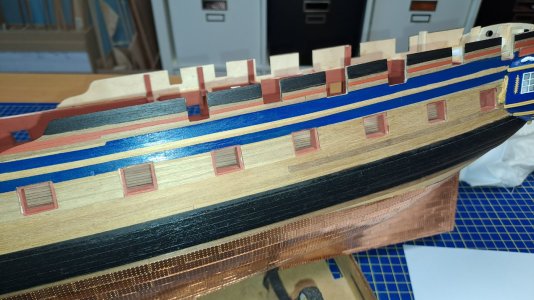




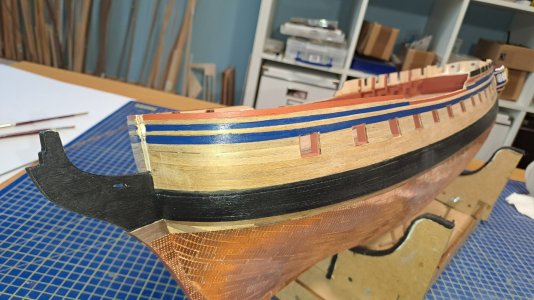
I carefully measured the exact location of the 3 mm wide rails... (waist rail, forecastle wail and the thinner (2mm) planksheer rail.
Then I used tape (3mm and 2 mm) and carefully installed them on the Hull, marking the exact position of the rails...
Then I painted the spaces between as mentioned in the plan....
If you first glue the rails and then paint between them, I am convinced that you will spill paint on the rails... painting first and then gluing gives a very neat result... right?
Next step: installing the fenders and the rails....











